Tbilisi Public Transport Guide with Tips and Cable Cars
Tbilisi has a relatively well-organized and straightforward public transport system; however, for a foreigner, it might be like an adventure all on its own. This ultimate guide to Tbilisi public transport shows you how to navigate transportation in Tbilisi with detailed information and tips.
There is almost no place in the city where some sort of transport doesn’t go, including the outskirts. From blue marshrutkas or minibusses winding through narrow streets to the refurbished old metro cars zipping beneath the city, the transport system is part of the culture, especially if you want a truly local experience or are visiting on a budget.
This detailed guide to Tbilisi transportation provides insights into the means of public transport, what kind of cards you need, how to get from Tbilisi airport to city center, the best mobile apps to have, and other alternatives.
My Travel Essentials
Get an eVisa: Check if you need one at iVisa and fill out the form to get your eVisa easily.
Book a flight: I use Skyscanner or WayAway. The latter offers cashback with a Plus membership.
Airport transfers: Avoid the hassle of public transport and pre-book a transfer with Gotrip.
Reserve a hotel: My go-to platform for hotels or apartments is Booking.com.
Wine tours: Eat This! Tours offer premium wine tours. Use code RFD5 to get 5% OFF.
Hiking & culture tours: WT Georgia is the best for unique trips. Email them Red Fedora & get 10% OFF.
Find best-suited tours: For other tours, entrance tickets, and activities, I use Viator or Get Your Guide.
Rent a car: With affordable prices, Local Rent is one of the best car rental platforms.
Hire a driver: GoTrip is ideal for long-distance private transfers at very reasonable prices.
Debit card: I have Wise (an alternative to Revolut) for local money withdrawals without hidden fees or high exchange rates.
eSIM: To avoid heavy roaming fees, use Airalo or Saily. Compare prices and GB packages. Use BAIA2592 on Airalo and BAIAIR6152 on Saily to get 3 USD on both.
Travel insurance: SafetyWing covers health insurance and has add-ons for adventure sports and electronics theft coverage.
Disclaimer: Some of the links in this post are affiliate links, which means I may earn a small commission if you buy something through them—at no extra cost to you. It helps support my blog and lets me share real, first-hand travel tips. Learn more
Tbilisi public transport tickets and prices
Tbilisi doesn’t have paper or token public transport tickets you might be used to in other cities worldwide. Instead, we use plastic cards, which I explain below. You can’t buy single tickets on buses anymore with coins.

We don’t have zones either, and no matter your destination or duration of your travel, the price remains the same for all means: metro, bus, and marshrutka are all 1 GEL. However, the ticket is valid for 90 minutes if you need to change the transport. In that case, you still need to tap the card again!
Cable cars in Tbilisi cost from 1 to 2.5 GEL one-way, depending on the ropeway. Mtatsminda Funicular and Mtatsminda cable car both require a separate card and cost 10 and 12 GEL, respectively, one-way, with an additional 2 GEL for a non-refundable card.
Tbilisi public transport overview
Tbilisi Transport Company oversees public transport, including a few cable cars. It is also responsible for any changes, including fares, routes, or operating hours. In 2022, the company upgraded the whole system and changed numbers to more than 70 buses and marshrutkas. You can see the changes on this website.

Even though we have a simple public transportation system, it can be slightly challenging for first-time visitors. There are English titles on city buses and metro lines, and the subway also announces stops in English but minubuses only have Georgian text on the rear window.
Unfortunately, there is no night public transport in Tbilisi. We used to have one from Tbilisi airport to city center, with a final stop at Station Square, but it stopped operating during the COVID-19 pandemic and was never reinstated. I provide information below on how to get from the airport to the center.
Tbilisi Metro
Tbilisi Metro opened in 1966 and was the fourth metro system during the Soviet era. Back then, the Soviet Union required a population of over one million in the city to build a metro plan. Yet, Tbilisi was one of the few cities where work on the metro design began before the population reached one million.


Like any other subway constructed in the USSR, the metro in Tbilisi is deep underground to be used as a shelter in case of an emergency or attack. The deepest is Rustaveli station, with a 120 meters (394 feet) long escalator, making it also one of the deepest in Europe.
While our metro stations might not be as lavish with their decorations as those of Tashkent, Uzbekistan, or other post-Soviet countries, we do have a few beautiful stations ornamented with stucco and bas reliefs and mosaics. It is one of the attractions for those interested in Soviet relics, buildings, and history.
Currently, Tbilisi Metro has two lines totaling 27.3 kilometers (17.0 mi) and 23 stations. The changing station is Station Square,with passage located underground.


The first (red) line goes from Varketili to Akhmeteli (Gldani district) and has 16 stations, passing through central areas such as Rustaveli, Freedom/Liberty Square, Avlabari (for Abanotubani and Old Town), Marjanishvili (close to Fabrika Tbilisi), Station Square (for the Central Railway Station), and Didube (for main bus station). Isani and Samgori stations are also on this line for shared taxis, and Samgori (Navtlughi) bus station, respectively, for departures towards Kakheti’s Telavi and Sighnaghi towns.
The second (green) Saburtalo Line runs from Station Square to State University and only has seven stations. Unless you are up for exploring some iconic Soviet-era buildings and mosaics or looking for street art, you most likely won’t need it.
The trains are frequent and fast. Except for early mornings and late evenings, trains run every 2-4 minutes. It is pretty loud inside, so much so that talking or listening to something without noise cancelation headphones is nearly impossible. Because trains move fast and sudden speed up or slow down is standard, ensure you hold onto the handrail when standing.

Most of the stations have escalators, which, according to my foreign friends, move quite fast, while for me, they are pretty slow. In any case, be careful and attentive. You might want to hold onto the railing, too.
Each station has a small police station with one person patrolling the platform, while the escalators have a dedicated staff at both ends. Taking photos is technically not allowed inside the platforms, and if caught, you’d be asked to stop and put the camera/phone away.
There is basic signage inside every station, both in English and Georgian. Most stations have one exit, except for Samgori, Delisi, Station Square, and Medical University, but have multiple staircases from the exit door to walk up to the streets—however, no signs state which staircase leads to which street. As a local, I sometimes walk up the wrong staircases and back down to find the one I need. Only the State University station has the staircase signage.

The metro works every day from 6 am to 12 am, with the last one departing on both lines from the depot at midnight. The rush hours are between 8:30 am to 10 am and later from 6:30 pm to 8 pm. During this time, it is usually quite crowded and uncomfortable.
Green and blue buses
Tbilisi buses are well organized and run on set schedules, anywhere between 15-30 minute intervals depending on the route. In the small townlets of Tbilisi, such as Kojori (for hiking back to Tbilisi or Asureti German village), buses have 45-60 minute intervals.
Buses in Tbilisi come in two colors, blue and green, of various sizes and go to almost every district and neighborhood, especially to places where the metro is unavailable, for example, Vake neighborhood, Radio City, or Chronicles of Georgia.

Buses only stop at fixed stops. They usually have metal shelters with seats. In a few cases, it’s just bus street signs. Drivers stop at every station, so you don’t need to press the ‘stop’ button. Only a few stops are ‘on demand’ marked under the bus street sign with the Georgian word ‘მოთხოვნით.’
In some main avenues of Tbilisi, such as Rustaveli, Chavchavadze, Ketevan Tsamebuli, and Tsereteli, the buses have their own line, making traveling in rush hour in these areas more or less time-consuming.
Unlike many European cities, the timetable isn’t written at the bus stops. Instead, digital displays show the bus number, route name with first and last stops, and the arrival time at that particular stop. To differentiate a bus from a marshrutka, remember that bus numbers start with 3.
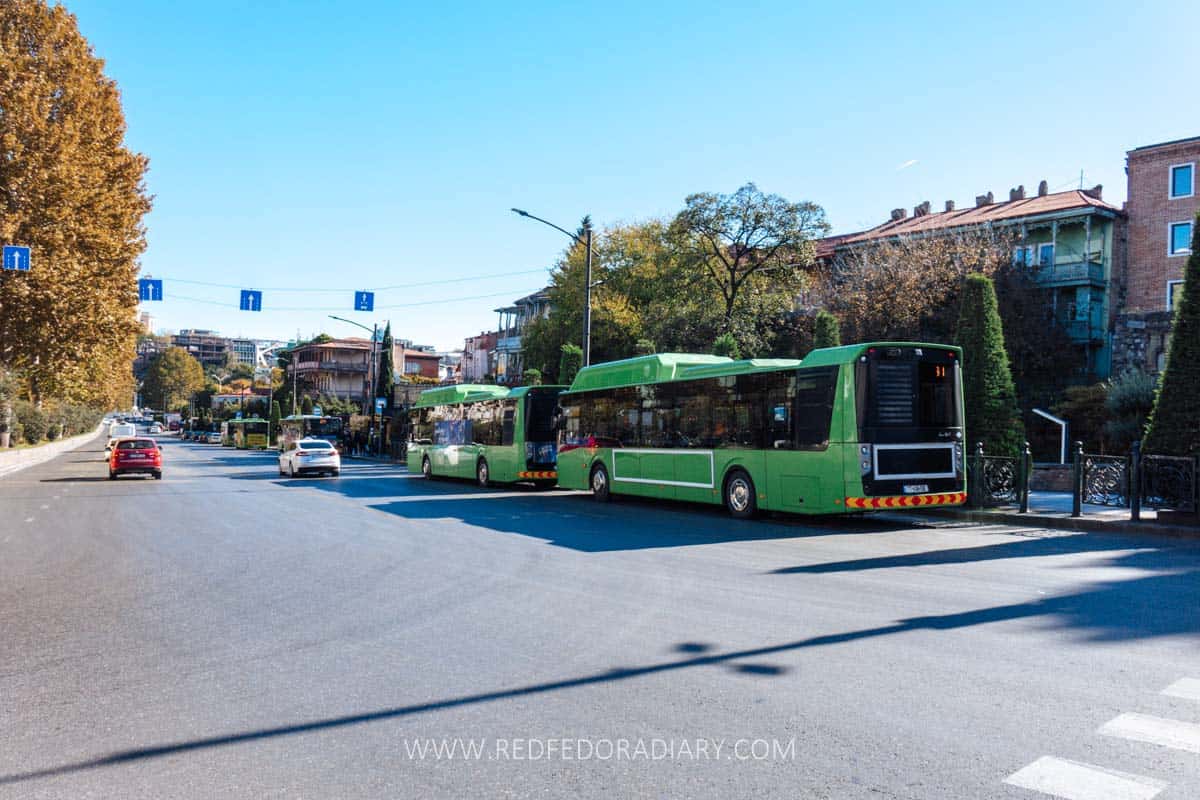
Even though the stops have names, they are not displayed either at the stops or inside the buses. Only a few have digital screens inside showing the approaching stops, mainly in Georgian. Therefore, monitor it with mobile apps (see below) to ensure you get off at your stop.
There is no designated door to use when entering/exiting the bus. Drivers do not sell tickets or handle anything passenger-related. Buses used to have bus stewards on board to ensure people paid the fair or help passengers if/when needed.
However, for the past couple of months, I haven’t seen them anymore. You can’t buy tickets with cash inside the bus anymore and must tap the card.
Tbilisi bus timetable depends on the bus line, but on average, they start at 7 am and run until 11 pm. There is no night bus in Tbilisi.
Local tip: every bus stop screen has an ID number, and a phone number indicated as SMS: [number] to send a text message for a real-time bus schedule. You need to have a Georgian SIM card to send it, though. Send the stop ID number (for example, 1885) to the 93344 number and wait for the reply. You’ll be charged 0.06 GEL for each SMS, even if you purchased an SMS package from your network carrier.
Blue marshrutkas (minibusses)
Similar to buses, marshrutkas have their own schedule. They are a fast means of transport for many locals but very chaotic for foreigners. They have different working systems from buses. I don’t particularly like traveling with a marshrutka and only do it when there is no other way.
They don’t stop at every designated stop unless requested and can drop you off anywhere, just like a taxi, except for main avenues and highways, where they must stop at bus stops.
If you want to board onto a marshrutka and stop it, you must hail it like a taxi. To get off, you must make a request using the Georgian word ‘gaacheret.’
With the new system introduced in 2022, the yellow marshrutkas were replaced by blue ones, with somewhat set timetables and a unified payment method. You can’t pay with cash either and need a card. Marshrutka numbers start with 4 or 5.
Their timings and destinations are shown on digital monitors and mobile apps. However, they have a sporadic schedule and may come to a stop earlier than the monitor says. In the evening, they also terminate work earlier than buses.
On longer and most popular routes, marshrutkas get packed with people standing in the aisle, making travel very uncomfortable for everyone. That said, I suggest sticking with a bus and a metro.
Tbilisi public transport cards explained
With a new system introduced in February 2022, all transport in Tbilisi has the same price: 1 GEL for 90 minutes. You won’t be charged extra if you change these transports within 90 minutes, but you need to tap the machine again when you board the second transport, and 15 minutes should be passed between the taps not to be charged twice.
As mentioned above, cash payments have been removed, and you need a specific Tbilisi public transport card. Traveling without a valid ticket will cost you a fine of 20 GEL.
Travel Card for weekly, monthly, and yearly use
Since 2022, Tbilisi has a subscription system for all means of transport – metro, bus, and marshrutka (also works on Maghlivi-Bagebi cable car) – valid for one day, one week, 1-6 months, and a year.

The unlimited Travel Card is ideal for those who often plan on using transport during their trip to Tbilisi or staying longer as an expat or a student, as it saves you money in the long run.
However, all packages are limited to 20 rides a day, and unlike MetroMoney (see second option below), you can’t pay for your partner or a family member with this card. It has no expiry date, your name, or any other personal information stored inside. Moreover, the card is rechargeable, enabling you to switch between the packages.
Tbilisi Travel Card prices:
- 1 day: 3 GEL
- 1 week: 20 GEL
- 1 month: 40 GEL
- 3 months: 100 GEL
- 6 months: 150 GEL
- 1 year: 250 GEL
Where to buy the Travel Card
Any cash desk at a metro station sells a blue Travel Card, and so do Bank of Georgia Express branches (make sure the bank’s branch has the word ‘Express’ on it). The card costs 2 GEL.
How to top up Travel Card
You can ask the cashier at the metro to top it up or use Bank of Georgia’s self-payment machines, the orange ATM-like machines you see inside the metro, in the streets, or at bus stops. These payboxes take coins (50 tetri, 1 GEL, 2 GEL) and paper banknotes.
Using the machine is pretty straightforward once you change the display to English. Tap on the ‘subscription‘ right on the home screen, select ‘buy a new subscription,’ and choose your desired package. Then, pay either by card or cash.
Remember that the machine doesn’t give a change back if you pay in cash. Therefore, slide the exact amount into the machine. Also, wait a few minutes for the card to activate, and don’t use it immediately after the purchase. The machine also shows the subscription dates and when it runs out.
MetroMoney Card for single travel & cable cars
The second option is the Tbilisi metro card called MetroMoney, which is also valid on the rest of the transport, including buses and marshrutkas. It is essential for the Rike Park-Narikala and Vake-Kus Tba cable cars.
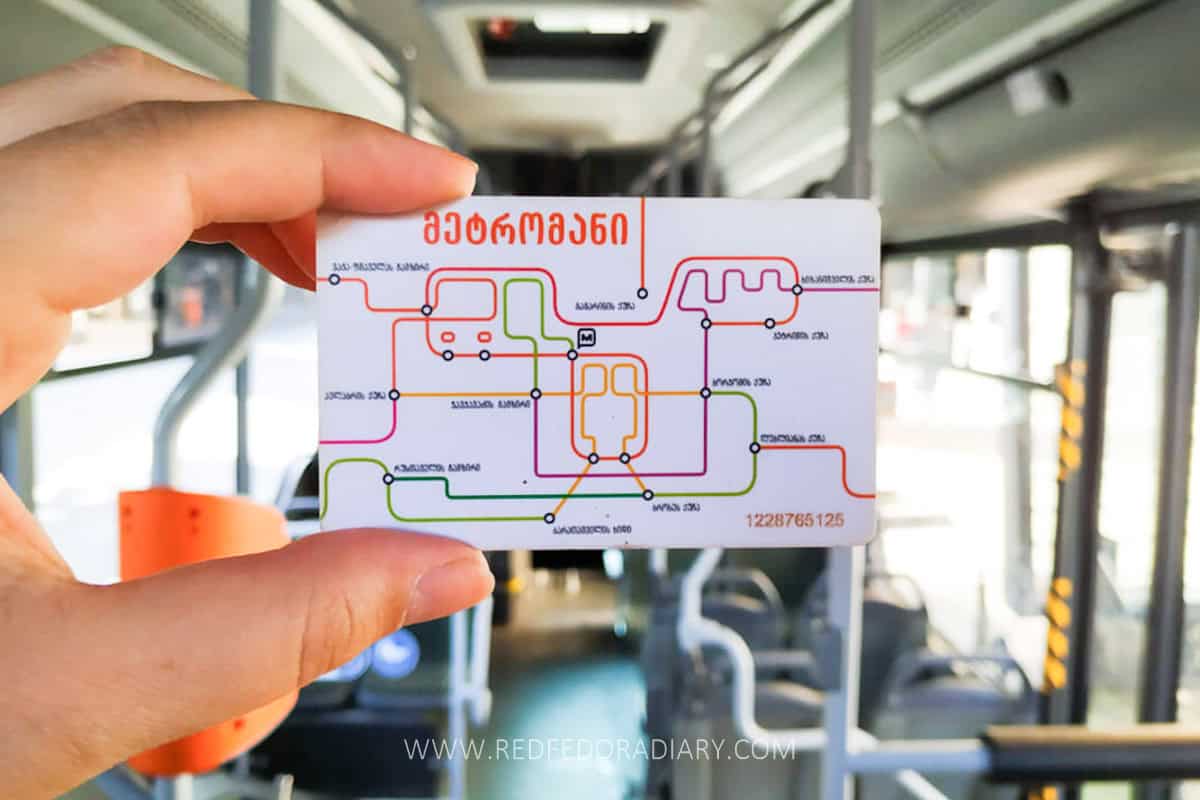
The card also costs 2 GEL. You can top it up with whatever amount you want or think you’ll need during the day or your time in Tbilisi. Like the Travel Card, MetroMoney doesn’t have an expiration date, your name, or any personal information.
When using the MetroMoney card, tap on the ticketing machine once. The screen will show the fare and your balance. The ticket is valid for 90 minutes. If you need to change the transport, you must tap the machine again when you board the second one, with 15 minutes passed between the taps, so you are not charged again.
If you are traveling with someone, you can share the MetroMoney card, but I’ve heard ticket inspectors are strict about it, so it’s better to be safe than sorry and have your own card.
Where to buy MetroMoney card
The process is similar to the one for the Travel Card explained above. You can buy MetroMoney either at the cash desk at the metro or the Bank of Georgia Express branch.
How to top up MetroMoney card
You can recharge the MetroMoney card at the cash desk of every metro station or with Bank of Georgia’s self-payment, ATM-like machines found at the metro stations, streets, and bus stops. These payboxes take coins (50 tetri, 1 GEL, 2 GEL) and paper banknotes but don’t return the change.
When using a paybox, place the card on the card reader and it will automatically open the screen to top up. Otherwise, select ‘transportation service‘ from the menu, then ‘transport card top up,’ insert the amount you want, and place the card on the reader.
International or local bank cards
Because we have card payments, the machines also work with international cards and local Visa/Mastercard cards as long as they have a chip. I have tested my Wise card, and it works great. However, note that the fare is 1.50 GEL per trip, and the bank will most likely add a conversion fee, too. Digital wallets with contactless payments also work with the machines.
This is convenient if you don’t plan to use transport in the city or are okay with a slightly increased charge. However, in other cases, I recommend buying one of the Tbilisi public transport cards as explained below.
Mobile apps for bus schedules and navigation
When using Tbilisi public transport, you only need two mobile apps – Google Maps and TTC, the official Tbilisi public transport app from the Tbilisi Transport Company. Both are very handy and have their perks.
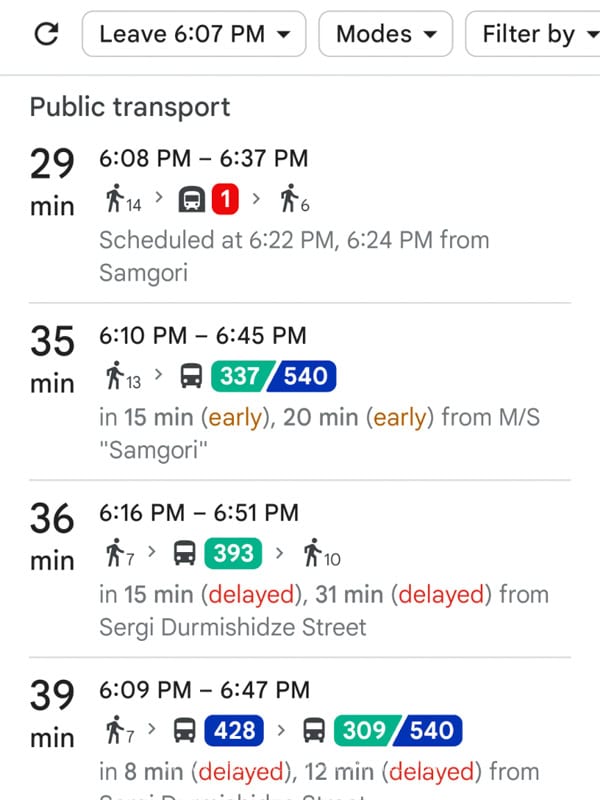

I prefer Google Maps for general navigation to see which bus, marshrutka, or metro I need to get from point A to point B. It displays the bus/marshrutka schedule and the time it will pass by a particular stop. However, the times for certain buses/marshrutkas might be inaccurate.
This is where TTC comes into play. They have upgraded the mobile app with more features, a working English version, and the possibility of buying transport and some cable car tickets. Although it’s a bit complicated if you need to change the transport within 90 minutes, so I’d stick with the cards mentioned above.
I don’t like its ‘Plan’ feature as it’s not very user-friendly and only shows transport departing at certain times, compared to Google Maps, which shows several options simultaneously.
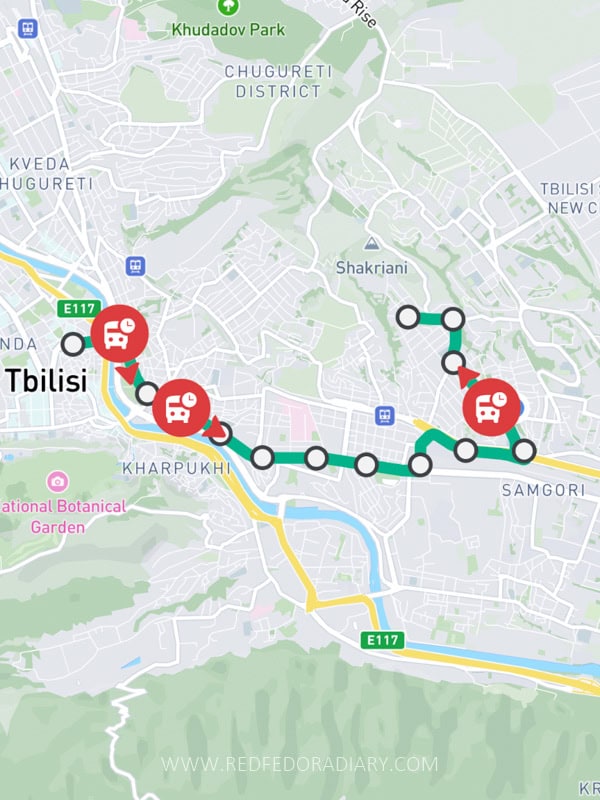
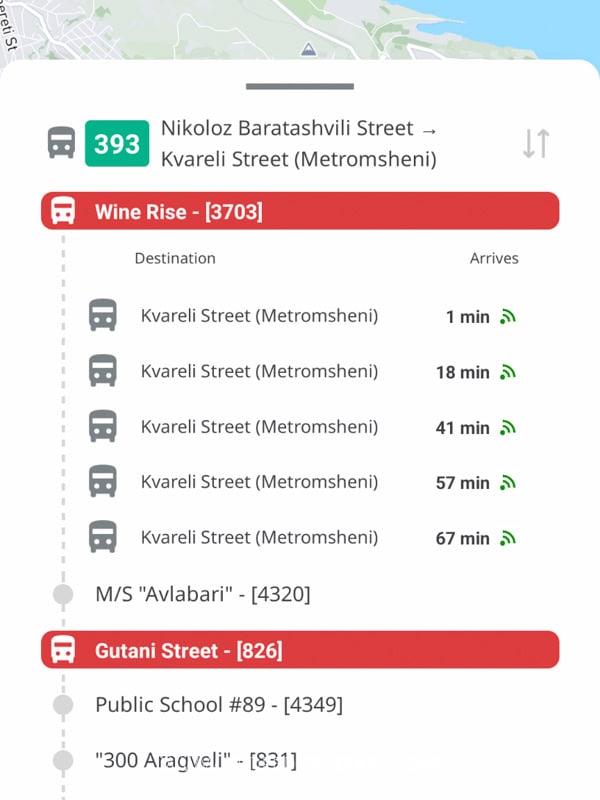
Instead, I use the TTC mobile app to monitor bus movement live by tapping the ‘Buses’ icon and searching for the bus number after I check on Google Maps. To change the direction, tap the arrow icons at the bottom right. Scroll up to see the list of stops; red highlight means the bus is at that stop at that time. You can also click on the stop’s name to see the following five arrival times.
It also has a timetable for each bus or a marshrutka slightly hidden in the menu. To find it, press ‘More’ and then ‘Schedule’ at the top.
You can also bookmark the bus and marshrutka numbers, which will be the first when you tap the ‘Buses’ icon but won’t be listed in the ‘Plan’ section.
Using taxis
Taxi is very affordable in Georgia. While you can hail a cab in the streets, downloading a taxi app in Tbilisi is better – you know the exact amount to pay, avoid negotiating the price or explaining the destination to a non-English-speaking driver, and have customer support available if you need assistance.
I use Bolt as my go-to Tbilisi taxi app (use code YRP76 to get discounts on your first rides), although there’s also Yandex, a Russian company with more low-quality service. Another one is Maxim Taxi, but it’s better for outside Tbilisi and has very few drivers in the capital.
I always pay by card for easy transactions and less worry about the change or the exact amount. However, cash payments are also available. When paying cash, note that some drivers might round up the amount as they might not have the exact amount to give you back.
How to use Tbilisi cable cars
Using cable cars in Tbilisi is an excellent way of traveling to slightly remote and elevated areas such as Kus Tba (Turtle Lake), Mtatsminda Park, or Narikala Fortress.
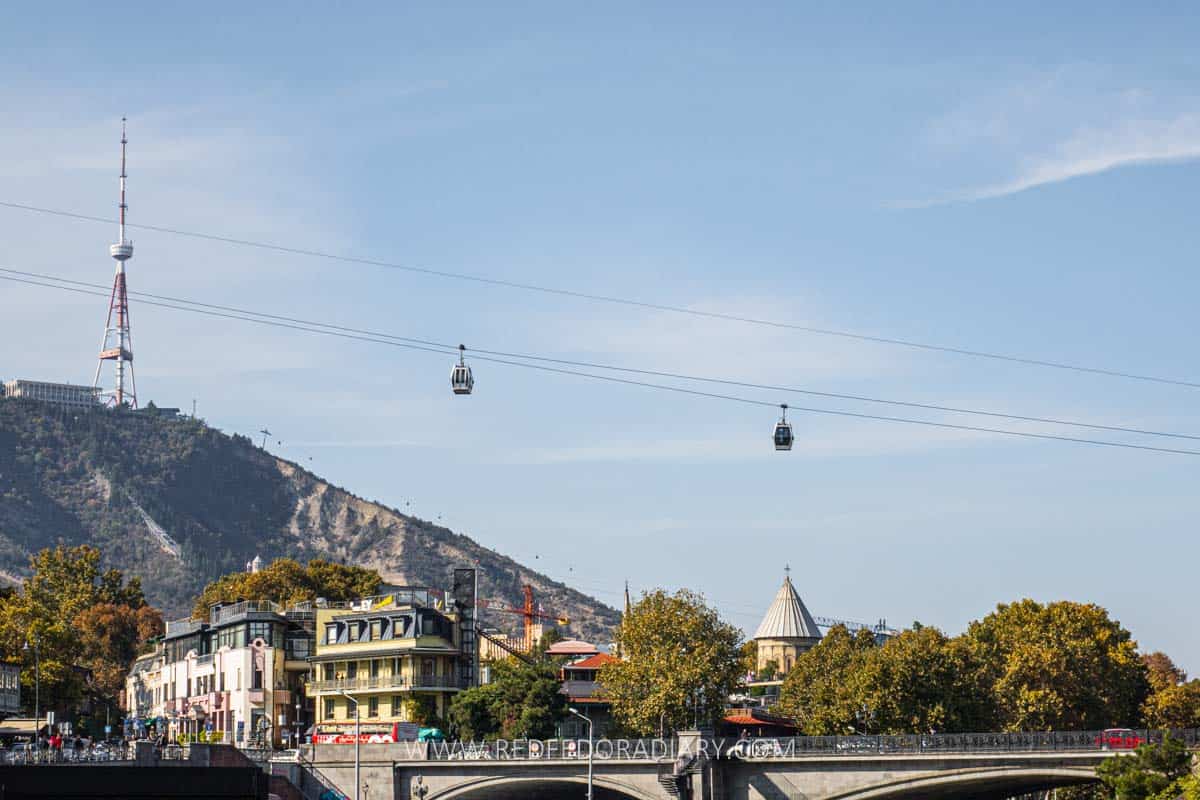
Tbilisi used to have around ten cable cars during the Soviet era, but most closed and fell into disrepair after the collapse of the USSR. A few stations are still around the city, some intact and others absorbed into various construction or building add-ons. One abandoned cable car even has a carrier hanging on the rope for over 30 years.
Currently, we have four working cable cars in Tbilisi and one funicular. Three of them are renovated Soviet-era ropeways, either having the same-looking carriers or completely modern ones, adding another thrill to the experience.
Rike Park – Narikala Fortress cable car
Compared to three other Tbilisi cable cars, Rike Park-Narika Fortress is a new ropeway that opened in 2012. It connects the park with the fort, Mother of Georgia statue, and Botanical Garden. The ride is short, but the views over the Mtkvari River and parts of the Old Town are fantastic.
- Opening hours: daily from 10 am to 12 am during summer and from 10 am to 10 pm in winter.
- Ticket price: 2.50 GEL one-way.
- Card needed: MetroMoney or Visa/Mastercard. You can also buy the ticket via the TTC mobile app. MetroMoney card is also sold at the cash desk.
Rustaveli Ave – Mtatsminda cable car [reopened in 2024]
In October 2024, a restored Soviet-era cable car from Rustaveli to Mtatsminda Amusement Park, the Funicular Restaurant, and the TV Tower opened after being abandoned for 34 years.


The new cableway spans 845 meters with 21 modern gondolas, each fitting eight people, and takes around 4 minutes to reach the upper station at the Funicular building.
It works smoothly and offers gorgeous views of Rustaveli, Mtatsminda and Chughureti neighborhoods, Mtkvari River, and beyond. Some gondolas have glass floors so that you can have an alternative viewpoint.
Initially opened in 1959 to commemorate 1500 years of Tbilisi’s foundation, the cable car operated until 1990. It was closed down right after a tragic accident on June 1 that killed 19 people and injured more than 40.


The lower station at Rustaveli Avenue is a stark example of Soviet architecture with tall windows, ornamental ironwork, and a gorgeous double-helix staircase. Pictured above is ‘Abandoned Vs. Renovated‘ of the same stairs taken in 2019 when I sneaked inside through a narrow metal decoration section that didn’t have a glass and got stuck for a minute on my way out.
- Opening hours: daily from 12 pm to 9 pm.
- Ticket price: 3 GEL one-way for Georgian citizens and residents upon showing the ID. Other nationalities – 12 GEL one-way. Children under 6, FREE of charge.
- Card needed: Mtatsminda Park card, costing an additional 2 GEL, which is also the only way to pay for the rides within the park. Other cards aren’t valid here.
Tbilisi Funicular to Mtatsminda Park
The Tbilisi Funicular opened in 1905 and was built as part of an urban plan to develop the Upper Tbilisi settlement and connect it to Lower Tbilisi. However, the project didn’t go through.
With the lower station at Chonqadze Street, the funicular takes passengers to the same Mtatsminda Park mentioned above. It is 501 meters long and stops midway at Mamadaviti church and Mtatsminda Pantheon of famous Georgian public figures.
Whether you take it from the bottom station or the other way round, the views from the funicular are spectacular as you slide up/down the hill and enjoy panoramic views of the city.
- Opening hours: daily from 10 am to 11 pm or midnight, depending on the season.
- Ticket price: 3 GEL one-way for Georgian citizens and residents upon showing the ID. Other nationalities – 10 GEL one-way. Children under 6, FREE of charge.
- Card needed: Mtatsminda Park card, costing an additional 2 GEL, which is also the only way to pay for the rides within the park. Other cards aren’t valid here.
Vake Park – Kus Tba cable car
Running from Vake Park (entrance from the Chavchavadze Ave and not the park) to Kus Tba, or Turtle Lake in English, is the only public transport to the lake. There are no buses or marshrutkas.
Moreover, it is one of the renovated Soviet-era ropeways with its original blue carrier and tight space! It’s a lot of fun and a ride worth experiencing. The views of Vake Park, its lush greenery, and the massive Victory Monument are also gorgeous.
Once up, you can walk around the lake, only 1 km long, sit back and relax at one of the cafes, or walk down to the Open Air Museum of Ethnography.
- Opening hours: daily from 10 am to 10 pm.
- Ticket price: 1 GEL one-way; bicycle transportation is an additional 1 GEL.
- Card needed: MetroMoney or Travel Card. You can also buy the ticket via the TTC mobile app. MetroMoney card is also sold at the cash desk.
Tbilisi State University (Maglivi) – Bagebi cable car
The Bagebi–Maglivi cable car is also a renovated Soviet-era relic with its original rectangular blue gondola. The ropeway, reopened in 2021, connects Tbilisi State University’s Maghlivi building in Saburtalo with the former student dorms (now a residentail building of IDPs) in Bagebi, Vake.
Since it’s a communal ropeway with nothing to see around except a few street art pieces, the dorm building itself as a Soviet architectural example, and the striking pedestrian Red Bridge, it’s a thrilling experience as it glides 320 meters above the Vere River gorge, offering spectacular views.
- Opening hours: daily from 8 am to 8 pm.
- Ticket price: 1 GEL one-way;
- Card needed: MetroMoney or Travel Card. MetroMoney card is also sold at the cash desk.
How to get from Tbilisi Airport to city center
Getting from Tbilisi airport to city center can be both easy or slightly complicated depending on when you land and where your hotel or accommodation is. With no night bus operating since the COVID-19 pandemic, the only options are the day bus or taxi.
Tbilisi city bus 337 runs from Tbilisi airport to Station Square, passing through the city center, including Avlabari metro (a 15-minute walk from Abanotubani and the Old Town), Baratashvili (another good stop for part of the Old Town), Freedom/Liberty Square, and Rustaveli Avenue.
The first bus departs at 7 am on workdays and 6:55 am on weekends, while the last one leaves at 11 pm on workdays and at 10:57 pm on weekends. The bus departs at 15-20 minute intervals.
You can buy the Travel Card or the MetroMoney card from the Bank of Georgia office inside the airport or from the TTC mobile app (if you don’t need to change the transport). Alternatively, use your international chipped card, which will charge you 1.50 GEL instead of 1 GEL (with a possible conversion fee added), and get the card if needed in the city center.
If you arrive late at night or early in the morning outside of the bus schedule, you can order a taxi or pre-book your airport transfer. Taxis standing outside the arrivals hall charge a lot and tend to scam tourists, so don’t use it. Instead, have the Bolt taxi app (use code YRP76 to get discounts on your first rides) on your phone and use either public wi-fi at the airport or have eSIM. I use either Airalo or Saily when traveling. Use BAIA2592 on Airalo and BAIAIR6152 on Saily to get 3 USD on both.
For peace of mind, pre-book a transfer with GoTrip, a driver service I occasionally use when traveling outside of Tbilisi. The fair starts from 52 GEL – quite reasonable for meeting you inside and driving you to any location in Tbilisi. If you are not staying in Tbilisi, you can also pre-book the transfer from the airport to many other places across the country.

Dear Red Fedora,
Can you tell me please if I just want get through the city from the Airport to the Didube Bus Station is it still available and possible to buy a 90 minutes ticket? I really dont want to get any of the Travel card you mentioned above. Thanks your reply in advance.
Best regards, Zsombor
Hi, you don’t have to buy the cards and use your international Visa/Mastercard to purchase tickets. You’ll need to change the transport so you have to tap it every time you board a new vehicle. However, within 90 min you won’t be charged.
Great guide! I had no idea the metro system was so efficient in Tbilisi. The tips on buses and minibuses were super helpful too. Thanks for making navigation so much easier for new visitors!